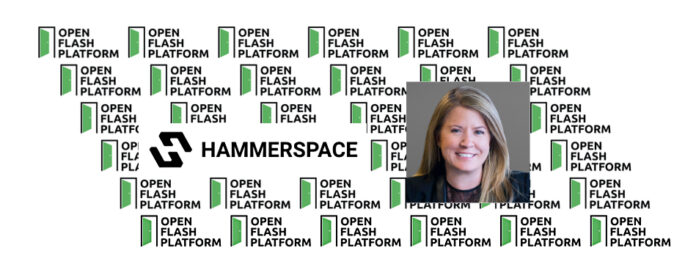Interview: The Open Flash Platform (OFP) group aims to replace all-flash arrays with directly accessed flash cartridges that have a controller DPU, Linux and parallel NFS (pNFS) software, and a network connection. That outline was revealed yesterday. We now have more details from the OFP and a context statement.

Hammerspace is effectively leading the initiative, and global marketing head Molly Presley told us more about the background that led to the OFP group being set up. “As datacenter designs evolve, particularly in neoclouds, hyperscalers, and large AI companies, several constraints on infrastructure have appeared that legacy architectures don’t accommodate for. Storage systems that are focused on power efficiency, scalability, and simplicity of design are urgently needed in AI architectures in order to liberate power for GPUs, scale to the data capacity demands, and deploy fast.
“The OFP initiative would like to see a new solution that provides the most scalable, dense system for storing data power efficiently and cost effectively. With AI driving the need to move from PB scale to EB scale, more efficient and scalable architectures are needed beyond what the current systems defined on legacy building blocks can provide.
“The current default shared storage architecture and platforms have limitations to scaling and density that make them ill suited to the needs of environments that face massive data growth to fuel AI applications. Customers are currently using power-hungry servers running proprietary storage software, often backed by enclosures that are based on a disk drive form factor rather than a design that is optimized for flash density.
“The current generation of IPUs/DPUs has made this new low-power, high-density form factor possible. By coupling them with a flash-optimized enclosure and leveraging the advancements in standard Linux protocols for high-performance data services, we can deliver storage solutions that are extremely efficient while also driving down costs (i.e. no node level licensing, extending the service life to the flash lifetime of eight years, rather than server refresh cycle of five years, dramatically reducing power, space and cooling requirements).
“None of this is new on its own, but the OFP initiative seeks to combine the advancements in the capabilities of offload engines, NAND technology, and Linux capabilities available today into a design targeting an urgent industry need. This cannot be accomplished with another proprietary silo, and thus wider industry participation and adoption will be an essential goal of the initiative.”
We asked the group a set of questions and Presley sent the answers back.
Blocks & Files: How is the OFP funded?
OFP: Hammerspace has funded the initial engineering study to explore options for a working POC/reference design. ScaleFlux, Samsung and two other SSD vendors (who we do not yet have corporate approval to reference in the OFP initiative) provided SSDs. Xsight and other IPU/DPU vendors (who we do not yet have corporate approval to reference in the OFP initiative) have supplied development boards for the project. SK hynix and LANL have been doing demonstrations of pNFS capabilities leveraging native Linux storage and NFS functions. In summary, the initiative’s members are all bringing their technology and expertise to the table.
Blocks & Files: How is the OFP governed?
OFP: We are actively recruiting partners, but have not considered wider governance rules beyond the initial engineering-level collaborations between the participants. We have some concept of existing governing bodies that might get involved in the future and have some proposals in preparation for them. But those are future discussions.
Blocks & Files: What classes of OFP membership exist?
OFP: Participation falls into one of two categories: 1) technology providers; and, 2) end-user advisors. The OFP concept has been socialized with dozens of large-scale end users as well. Their input is being taken into design considerations.
Blocks & Files: Who defines the OFP cartridge specification in terms of physical form factor, SW interface, network interface, DPU form factor and interface, power interface and amount, etc.?
OFP: Initially, Hammerspace has developed a proposed reference specification for the tray, cartridge, electrical interfaces, software, thermals, etc. We are actively seeking feedback from not only members of the initiative, but prospective customers as well. Other implementations would also be welcome.
Blocks & Files: Does an OFP cartridge specification exist?
OFP: We have a preliminary specification that allows both standard and new form-factor SSDs to reside in the cartridge, and are working within the group of initiative partners to solicit feedback before announcing anything publicly. We anticipate further announcements regarding the canister and tray designs during the second half of 2025, including a working prototype for public demonstration toward the end of the year.
Blocks & Files: How is OFP cartridge product specification compliance validated?
OFP: TBD.
Blocks & Files: Who defines the OFP tray specification?
OFP: Same as above. Initially.
Blocks & Files: Does an OFP tray specification exist?
OFP: Yes, see above.
Blocks & Files: Which datacenter rack designs does the OFP tray specification support?
OFP: First reference design will be EIA 19″ rack but we also have plans for an OCP 21″ rack design.
Blocks & Files: Which suppliers build OFP trays?
OFP: Initially, only a contract manufacturer but discussions with OEM and system integrators are in progress.
Blocks & Files: How is OFP tray product specification compliance validated?
OFP: TBD
Blocks & Files: How does the OFP relate to the Open Compute Project (OCP)?
OFP: We are already working with Meta on ultimately having this OFP initiative subsumed into OCP. That is the ultimate goal.
We have seen considerable industry-wide interest, with more partners joining the conversation in the design requirements as well as likely new members joining the public effort in the coming weeks. We also have substantial early customer interest. Releasing information about the initiative as it matures is incredibly important to the datacenter designs and infrastructure strategies being planned for the coming years. As you well know, massive investments in AI are in the works. Visibility to emerging architectures is very valuable as the industry evolves at such breakneck speed.








